Nissan Motorsports International Co., Ltd., abbreviated as Nismo, is the in-house tuning, motorsports and performance subsidiary of Nissan Motor Company. Formed in 1984 as a result of a merger of two motorsport departments, Nismo has competed in JSPC, JTCC, the 24 Hours of Le Mans and the 24 Hours of Daytona. They currently participate in the Super GT, the Blancpain GT Series and Formula E.

The Mazda 787 and its derivative 787B are Group C sports prototype racing cars that were developed by Japanese automobile manufacturer Mazda for use in the World Sportscar Championship, All Japan Sports Prototype Championship, and the 24 Hours of Le Mans from 1990 to 1991. Designed to combine a mixture of the Fédération Internationale du Sport Automobile (FISA) Group C regulations with the International Motor Sports Association (IMSA) GTP regulations, the 787s were the last Wankel rotary-powered racing cars to compete in the World and Japanese championships, using Mazda's R26B engine.
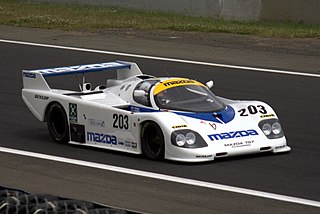
The Mazda 757 is a prototype racing car built by Mazdaspeed for the 24 Hours of Le Mans running under the IMSA-spec GTP class. It replaced the previous lineage of Group C2 class cars which ended with the 737C and was the first chassis built entirely by Mazdaspeed and designed by Nigel Stroud. The 747 designation was skipped to avoid confusion with the second generation Mazda RX-7, which was developed under the codename P747. The 757 used a new 3-rotor 13G Wankel engine.

Group C was a category of motorsport, introduced by the FIA in 1982 and continuing until 1993. Group C applied to sports car racing, with Group A for touring cars and Group B for GTs.

The Toyota TS010 was a Group C racing car built by Toyota for the Sportscar World Championship, All Japan Sports Prototype Championship, and the 24 Hours of Le Mans.
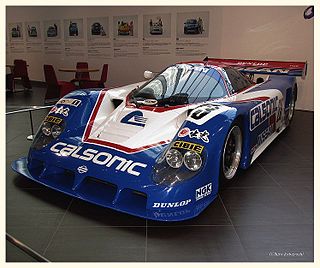
The Nissan R89C was a Group C sports prototype developed by Nissan.

The Mazda MXR-01 is a Group C sports prototype that was used by Mazda's factory team Mazdaspeed in the 1992 World Sportscar Championship season. It would be the final Mazda entry in sports car racing since the inception of its Le Mans project in 1983. It was based on the Jaguar XJR-14.
Masanori Sekiya is a racing car driver, most famous for being the first Japanese driver to win the 24 Hours of Le Mans, in 1995.
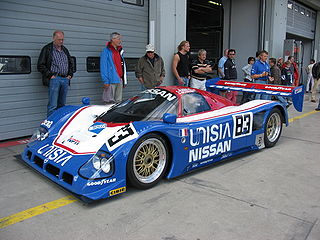
The Nissan R90C was either of two Group C racing cars built in 1990 for Nissan Motors for competition in World Sportscar Championship (WSC) based in Europe and the All Japan Sports Prototype Championship (JSPC). The cars based on the basic R90C platform would compete until 1993 before Nissan chose to withdraw from sports car racing, not returning until 1997. It won three JSPC championships as well as several significant endurance races during its career.
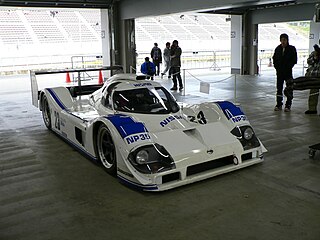
The Nissan P35 was a planned Group C car built by Nissan Motors for competition in the World Sportscar Championship. Developed by Nissan Performance Technology Inc. (NPTI), which had formerly raced under the name Electramotive in the United States, the cars were intended to be completed by the middle of 1992, with competition starting in 1993. However economic troubles for Nissan led to the cancellation of the project soon after testing of the first cars had begun, meaning that the P35s never raced.
Richard Lloyd Racing (RLR), originally named GTi Engineering, was a British auto racing team created in 1977 by driver Richard Lloyd. Originally named for the Volkswagen Golf GTIs that Lloyd raced in the British Saloon Car Championship (BSCC), they went on to become a successful Porsche privateer in the World Sportscar Championship (WSC). Richard Lloyd Racing eventually folded at the end of the 1990 season due to the increased cost of the World Championship.
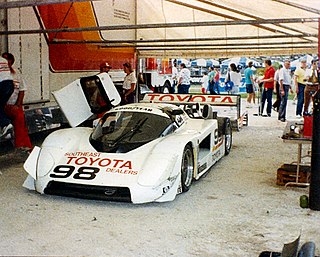
The Toyota 88C is a racing car entered by Toyota from 1988 to 1989. It is the successor to the Toyota 87C and the predecessor to the Toyota 88C-V. Like other Toyota-powered sports prototypes of the era, it was designed and built by Dome. The 88C is an evolution of the 87C, both models sharing the same chassis number designation. The 88Cs competed in the All Japan Sports Prototype Championship, the World Sports-Prototype Championship, and the North American Camel GT Championship.

The Nissan R88C is a sports prototype race car developed by Nissan and Lola for the 24 Hours of Le Mans.

The 6 Hours of Fuji is a sports car race held at Fuji Speedway in Oyama, Shizuoka, Japan. The race was held for the first time in 1967, and in 1977 became part of the new Fuji Long Distance Series. In 1982 a second 1000 km race known as WEC in Japan was run as a round of the World Sportscar Championship. The All Japan Sports Prototype Championship was formed in 1983, and since then co-sanctioned this event. The World Championship left after 1988, but the JSPC carried on both races until 1992. The race was revived in 1999 as an attempt to gauge interest in an Asian Le Mans Series; the series never materialized. The race was revived again as a part of the short-lived Japan Le Mans Challenge in 2007. The race returned again as part of the 2012 FIA World Endurance Championship season, but changed to a 6-hour race, with no distance limit.
Takao Wada is a Japanese former racing driver. He competed at the top level of Japanese Open Wheel racing between 1977 and 1993, scoring two wins, one pole position and five podium finishes over a career that spanned 14 seasons and 90 races, but he was better known for winning the 1979 Japanese Formula Pacific Championship and the 1986 Japanese Touring Car Championship.
The 1992 All Japan Sports Prototype Car Endurance Championship was the tenth and final season of the All Japan Sports Prototype Championship, which would be replaced by the All Japan Grand Touring Car Championship, as sportscar racing in the early 1990s changed drastically with the decline of prototypes. The C1 class champion was the #1 Nissan Motorsports Nissan R92CP driven by Kazuyoshi Hoshino and the C class champion was the #7 and #36 TOM'S Toyota TS010 driven by Geoff Lees.

The Ligier JS P2 is a racing car designed and built by French manufacturer Onroak Automotive and named in partnership with French former racing driver Guy Ligier. Designed for the Le Mans Prototype 2 (LMP2) regulations, it is intended as a second option to Onroak's Morgan LMP2 that has been competing since 2012. As well as being the first closed-cockpit car offered by Onroak, it is also the first car they designed entirely in-house. The JS P2 debuted at the 2014 24 Hours of Le Mans, and has been campaigned in the FIA World Endurance Championship, European Le Mans Series, Asian Le Mans Series and IMSA WeatherTech SportsCar Championship.

The March 86G was a Group C and IMSA GTP sports racing car built by March Engineering. Built as simply a chassis with no engine, it was branded as one of three cars, the BMW GTP, the Buick Hawk or the Nissan R86V depending on which engine was placed in the chassis and which team was running it. There were a number of subtle bodywork changes to reflect the manufacturer which ran the car.
The 2018–19 FIA World Endurance Championship was the seventh season of the FIA World Endurance Championship, an auto racing series co-organised by the Fédération Internationale de l'Automobile (FIA) and the Automobile Club de l'Ouest (ACO). The series is open to Le Mans Prototypes and grand tourer-style racing cars divided into four categories. The season marked the first move to a winter schedule for the championship, with the season starting at the Circuit de Spa-Francorchamps in May 2018 and concluding at the 24 Hours of Le Mans in June 2019. World championship titles were awarded for LMP drivers, GTE drivers, LMP1 teams and GTE manufacturers.

The 2019 6 Hours of Fuji was an endurance sports car race held on the 6th of October 2019, at the Fuji Speedway. It was the 2nd round of the 2019-20 FIA World Endurance Championship.














